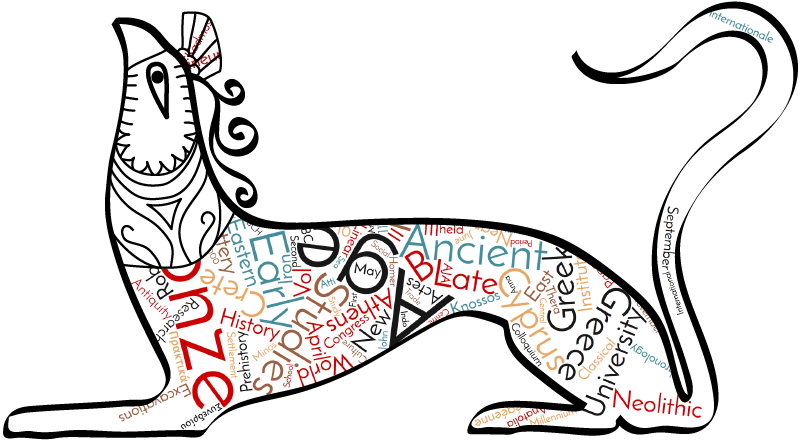
Latest
PoCA 2021
On 31 May 2021 abstracts (250 words maximum) are due for the 18th meeting of the Postgraduate Cypriot Archaeology (PoCA 2021), to be held from 9-11 December 2021 in hybrid form hosted in Basel. Postgraduate researchers and recent postdoctoral scholars (within six years of the completion of their PhD) from various backgrounds and disciplines are invited to present their work on Cypriot culture and archaeology. The official language of the conference is English. Communications should be 20 minutes long, followed by 10 minutes of discussion. Further information is available at https://www.ucy.ac.cy/aru/en/poca/current-poca and https://klassarch.philhist.unibas.ch/de/forschung/poca-2021/.
SAA 2022
On 9 September 2021 submissions, both session and individual (abstracts 200 words maximum), are due for the Society for American Archaeology 87th Annual Meeting (SAA 2022), to be held on 30 March - 3 April 2022 in Chicago, IL. Further information and submission forms are available at https://www.saa.org/annual-meeting.
13th International Congress of Cretan Studies
On 31 December 2021 abstracts are due for the ΙΓ΄ Διεθνούς Κρητολογικού Συνεδρίου. 13th International Congress of Cretan Studies, to be held in October 2022 in Agios Nikolaos, Crete; this is an extended deadline for the congress, which has been rescheduled in response to the current global health situation. Further information is available at https://www.13-iccs.gr/index_en.html. The themes of the congress will be:
• Upheavals, Ruptures, Discontinuities, Risings
• Health and Illness in Human Communities
ISA 2020-22
The 43rd International Symposium on Archaeometry (ISA 2020-22), which was to have been held in Lisbon, Portugal on 18-22 May 2020, has been postponed to 16-20 May 2022. Further information is available at https://www.isa2020-lisboa.pt/index.php.
TAG-Turkey 2021
On 6-9 May 2021 TAG-Turkey III 2021: Identities will be hosted online (UTC). Further information is available at https://www.tagturkey2021.com/?lang=en. Papers of interest to Nestor readers will include:
S. Cveček and C. Schwall, “Ghost Children: Fluid Identities of Children in Prehistoric Anatolia. Hayalet Çocuklar: Tarihöncesi Anadolu'da Çocukların Akışkan Kimlikleri”
A. Arslan, “Prehistorik Kil Buluntulardaki Parmak İzleri Bize Ne Anlatıyor? What Do Fingerprints on Prehistoric Clay Objects Tell Us?”
S. Mutlu, “Batı Anadolu’da Mö 5. Binyılda Kilia Figürinleri Bağlamında Kimlik. Identity in the Context of Kilia Figurines During the 5th Millennium BCE in Western Anatolia”
C. Mazzucato, “Unravelling the Knot. A Socio-Material Approach to the Study of Neolithic Megasites: The View from Çatalhöyük. Düğümü Çözmek. Neolitik Mega-Yerleşmelere Sosyo-Materyal Bir Yaklaşım: Çatalhöyük Örneği”
K. Argyraki, “The Role of Women in the Mycenaean Age. Miken Çağı'nda Kadınların Rolü”
E. Erdan, “Kadınsız Hareketlilik: Anadolu’yu Kapsayan Göç ve Kolonizasyon Süreçlerinin Eril Kimliği Üzerine Fibulalar Ekseninden Bir Yaklaşım. Mobility without Women: A Fibulae-Based Approach to the Masculine Identity of the Migration and Colonization Processes Involving Anatolia”
F. G. Slim, C. Çakırlar, and C. Luke, “Human-Pig Interactions and Group Identities in the Late Bronze Age Aegean and Anatolia. Geç Tunç Çaği Ege ve Anadolu’da İnsan-Domuz İlişkisi ve Toplumsal Kimlikler”
GAO 2021
On 7-9 May 2021 the Graduate Archaeology at Oxford Conference (GAO 2021): Interactions, Trade, and Mobility in Archaeology will be hosted online (GMT) in Oxford. Further information is available at https://www.gao2021.org/. Papers of interest to Nestor readers will include:
F. Iacono, “Interaction and its consequences: assessing the nexus between economic interaction, mobility, and settlement dynamics in the Mediterranean Bronze Age”
D. Pollard, “Micro-Regions and ‘The Great Divide’: Connectivity as a Concept in Cross-Disciplinary Research on Late Bronze Age and Early Iron Age”
J. Sienkiewicz, “Social Assemblages of Things: Drinking practices and interregional interaction in the Late Bronze Age east Mediterranean”
R. Charalampous, “Recontextualising the interactions, trade and mobility between Cyprus and Sardinia from the end of LBA to the IA”
D. Karampas and T. Theodoulou, “Crete and Maritime Archaeology: A Century of Discoveries”
P. Tzovaras, “Cultural trafficking in Greece: new perspectives on the authenticity of the Aegean lead boat models”
Seascapes
On 21-22 April 2021 a day school entitled Seascapes: Island and Coastal Life in the Aegean and Beyond from Prehistory to the Recent Past was hosted online by the Irish Institute of Hellenic Studies at Athens. Further information is available at https://www.iihsa.ie/events/seascapes-island-and-coastal-life-in-the-aegean-and-beyond-from-prehistory-to-the-recent-past. Papers of interest to Nestor readers included:
J. Murphy, “Joining the Dots: The Kea Archaeological Research Survey”
M. Milic, “The early history of island hopping: The growth of Aegean’s coastal communities in the 7th millennium BC”
B. Molloy, “The ups and downs of living on the Big Island: Maritime perspectives on crises in Crete during the Bronze Age”
C. Haywood, “Is there something special about islands? Some lessons to be learned from the Ionian Sea in the Bronze Age”
